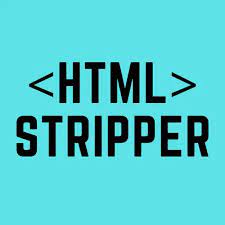In the ever-evolving world of web development, efficiency and precision are paramount. One tool that has been gaining immense popularity among web developers and content creators is the HTML stripper. In this comprehensive guide, we will delve into the world of HTML strippers, exploring what they are, how they work, their applications, and much more. So, if you’re ready to strip away the complexities and get to the heart of this essential tool, let’s dive right in!
What is an HTML Stripper?
To kick things off, let’s break down the concept of an HTML stripper. An HTML stripper is a software or script designed to remove HTML tags from a given document or text. These tags, which are essential for formatting and structuring web content, are sometimes unwanted in certain contexts, such as data extraction or cleaning text for various purposes.
Understanding the Mechanics
Before we explore the practical applications, it’s crucial to understand how HTML strippers function. The process is relatively straightforward. When you feed a document or text containing HTML tags into an HTML stripper, it scans the content and selectively removes all the HTML elements while leaving the plain text intact. This process is particularly handy when you need to extract valuable information from web pages, sanitize user-generated content, or prepare text for publishing across multiple platforms.
The Versatility of HTML Strippers
Now that we’ve established the fundamentals, let’s dive into the diverse applications of HTML strippers across various domains.
1. Web Scraping and Data Extraction
HTML strippers are indispensable tools for web scraping. They enable developers and data analysts to extract structured data from websites efficiently. By removing HTML tags, the content becomes more readable, making it easier to analyze and manipulate. Whether you’re tracking prices for e-commerce research or collecting data for market analysis, HTML strippers play a pivotal role.
2. Content Management and Cleaning
Content creators often face the challenge of dealing with HTML-rich text that needs to be repurposed. An HTML stripper is a time-saving solution to clean up the content. It simplifies the process of converting web-based content into formats suitable for print, e-books, or other media. This ensures that your content looks polished and professional, regardless of its source.
3. SEO Optimization
HTML strippers can aid in SEO optimization by removing unnecessary HTML tags that may affect a website’s search engine ranking. By stripping away the excess code, you can enhance your website’s performance, making it more attractive to search engines and users alike.
4. Email Marketing
In the world of email marketing, HTML strippers are used to ensure that emails are displayed consistently across various email clients. By removing extraneous HTML code, emails are less likely to encounter rendering issues, guaranteeing a seamless experience for recipients.
Choosing the Right HTML Stripper
With an array of HTML stripping tools available, it’s essential to select the one that best suits your needs. Here are some factors to consider when making your choice:
1. Features and Customization
Look for an HTML stripper that offers customization options. The ability to define which HTML elements should be removed or retained can be a game-changer for specific projects.
2. Performance
Speed is of the essence, especially when dealing with large volumes of data. Choose an HTML stripper that can process content quickly and efficiently.
3. User-Friendly Interface
An intuitive and user-friendly interface can make your HTML stripping tasks a breeze. A tool that is easy to navigate and understand will save you time and frustration.
4. Compatibility
Ensure that the HTML stripper you choose is compatible with your preferred programming language or software.
Best Practices for Using HTML Strippers
Now that you understand the significance of HTML strippers and how to select the right one, here are some best practices to make the most of this versatile tool:
1. Backup Your Data
Before stripping HTML from any content, always create a backup of the original document. This precautionary step ensures that you can revert to the original if needed.
2. Test and Refine
HTML stripping may require some trial and error. Test the results of your HTML stripper to make sure it’s achieving the desired outcome. Adjust settings as needed to refine the process.
3. Regular Updates
Keep your HTML stripper software or script up to date. Updates often include bug fixes and new features that can improve performance.
4. Documentation
Maintain documentation of your HTML stripping processes. This will help streamline future projects and ensure consistency.
Conclusion
In the fast-paced world of web development and content creation, HTML strippers have emerged as invaluable tools for streamlining processes, improving data quality, and enhancing user experiences. From web scraping to content management and SEO optimization, the applications of HTML strippers are wide-ranging and essential for anyone working with web content. By selecting the right HTML stripper and following best practices, you can harness the power of this tool to achieve your goals efficiently and effectively.
So, as you embark on your journey with HTML strippers, remember to choose the right tool, embrace best practices, and unlock the true potential of this versatile technology. Happy HTML stripping!
